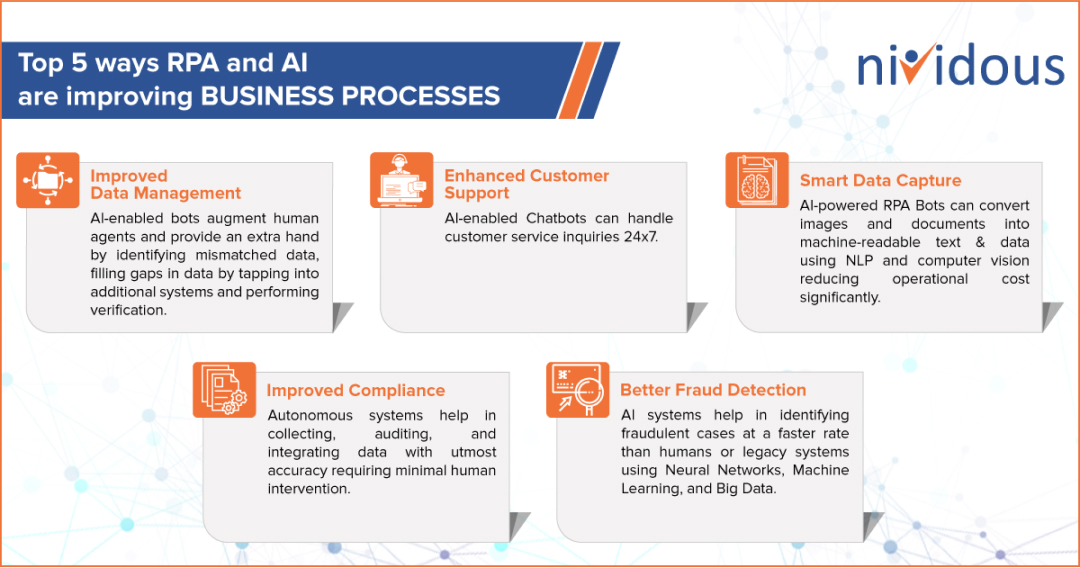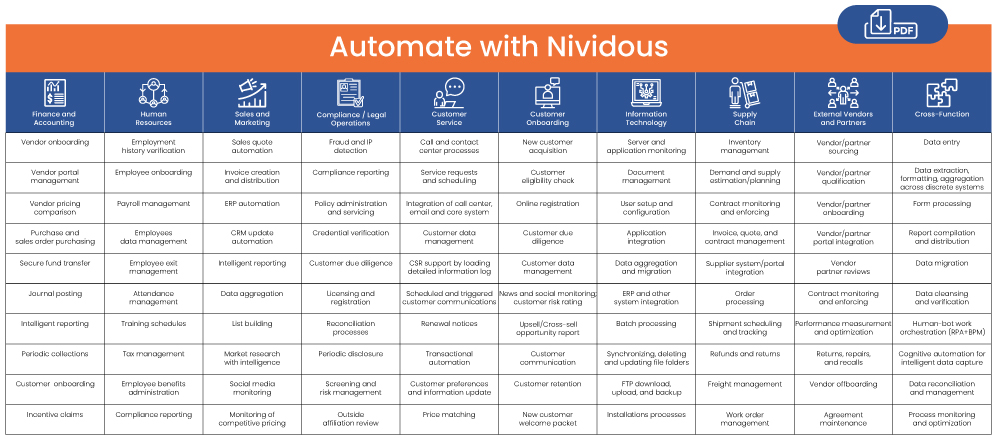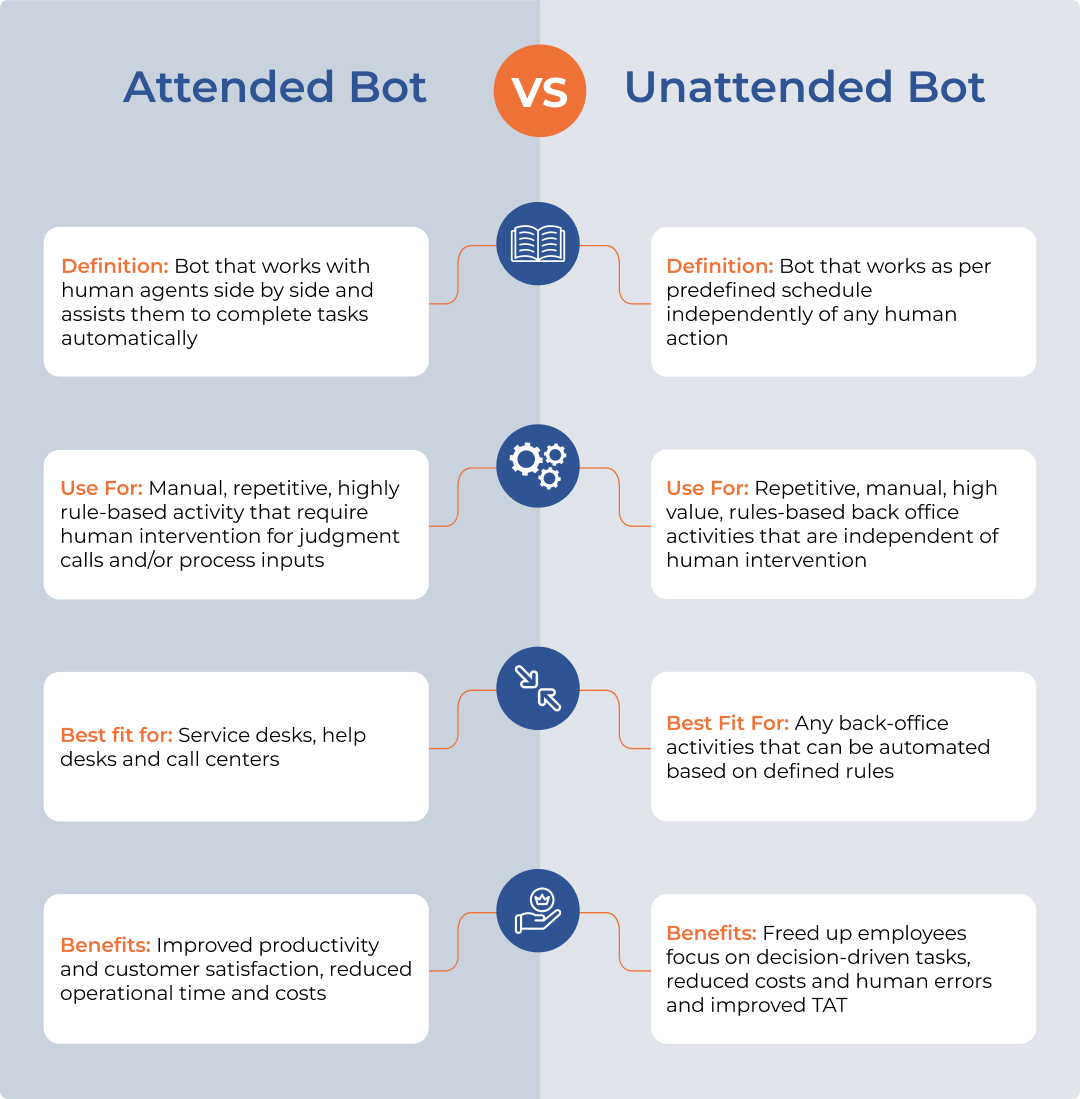Robotic Process Automation (RPA)
Learn everything about RPA, an automation technology that ends repetitive tasks and makes digital transformation a reality
What is RPA?
Robotic Process Automation (RPA) is the use of software robots, or “Bots,” to complete repetitive, rules-based tasks within or between computer systems. The Bots perform this work through existing user interfaces, so there is no need to construct original software integrations.
With RPA, users train Bots to operate software almost as a human would (not necessarily at the keystroke level, but using the same user interface and generating the same results). Processes that require multiple programs to complete can also be completed in this way. Once trained to perform a task, Bots can then scale to meet changing demand.


Bots quickly perform tasks the same way every time, without any need for breaks or quality checks. Data-heavy, back-office processes are excellent candidates for RPA. Bots can take over data entry or migration between spreadsheets, for instance, or between emails, contact forms, or reporting platforms—though these are just a few examples of the many uses for RPA.
RPA Bots are smart to start with, but they can also learn as they go. Artificial intelligence (AI) and machine learning are built in for continuous improvement. For more complicated business processes, Bots and humans can work together with great results.
To sum up: What is RPA? It is a software solution for simple, repetitive tasks; it is a digital labor-saving tool; it is the key to freeing staff for higher-level activities.
The Best Way To Understand RPA Is To See it in Action
Schedule a free, personalized demo to experience the Nividous Platform today.
How does RPA Differ from Traditional Automation?
Digital automation traditionally required the development of custom software integrations—or even one-of-a-kind automated platforms. Enterprises had to hire developers to construct these systems, which carry significant costs and may take years to deploy.
With RPA, Bots learn to use the systems that are already in place, operating entirely on the front end of existing digital ecosystems. Automations built on the Nividous platform can be up and running in production within weeks rather than months or years.
As a result, RPA allows users to automate business processes at a fraction of the time and cost. RPA is compatible with all digital interfaces, using existing infrastructure without affecting the underlying systems. This avoids the most significant cost element of many automation projects. With RPA, businesses can rapidly modernize and scale their operations without the need for costly and scarce technology skills.
Rapid ROI (in months)
Minimal Upfront Investment
Highly Scalable
Flexible and Intelligent
Led by the Business with IT Support
What are the Benefits of RPA?
Quick Adoption
RPA is easy to build and quick to implement.
Greater Accuracy
RPA Bots are faster and 100% accurate.
Better Customer Experience
Faster and quality communication for an improved experience.
Utilize Artificial Intelligence
Enhance the scope of automation with smart Bots.
Robotic process automation solutions from Nividous are user-friendly, allowing companies to build RPA Bots on their own, without an extensive team of developers or deep knowledge of programming languages or artificial intelligence technologies.
Introducing RPA helps to modernize existing solutions without creating new interfaces and integrations. Immediate benefits of RPA include a dramatic reduction in human errors, operational cost, and manual work, including auditing and compliance management.
Automation allows companies to reinvest hours of staff time in value-added work and innovation. With RPA, businesses gain incremental revenue opportunities that can accelerate digital transformation, delivering even higher returns. RPA delivers value to any business by:
- Allowing employees to focus on high value tasks that only they can do
- Improving employee engagement/satisfaction
- Increasing employee productivity
- Increasing employee retention
- Improving customer experience
- Providing rapid scalability with no training requirement
- Eliminating errors on repetitive tasks
- Enabling integration of disparate systems and their data
- Drastically reducing the time necessary to complete tasks
- Allowing off-hours or around the clock processing of automated tasks
Curious To Learn How To Leverage These Benefits?
Check out this detailed blog post on RPA benefits with real-world business examples.
What Business Processes Benefit most from RPA?
Because RPA Bots are inherently customized, no list can cover every possible use of the technology. Every Bot is trained for the specific tasks that produce the most value for a given business.
That is why the Nividous Quick Start Program starts with an ideation workshop, in which Nividous consultants work with teams to identify the RPA-eligible processes that will achieve the greatest results for their unique business circumstances. However, the tasks on this graphic are field-tested and proven to achieve a quick ROI for 10 areas primed for digital automation.
What Industries use RPA?
According to Gartner, 90 percent of large organizations around the world will deploy some form of RPA by the end of 2022—and those companies’ RPA portfolios will triple in capacity through 2024.
Undoubtedly, the adoption of RPA is on the rise due to its ability to deliver quick ROI and enhanced control of business operations. Companies in a wide range of industries, including insurance, banking, healthcare, logistics and many more benefit from RPA.
Looking For Automation Use Cases For Your Industry?
Discover how businesses are using RPA and end-to-end intelligent automation at work.
Attended vs. Unattended RPA Bots: What’s The Difference?
Bots that operate entirely on their own are called unattended RPA Bots, whereas if they are assisting staff on demand, they are termed as attended Bots.
An example of an attended RPA Bot is when a customer service executive demands or activates a Bot to execute an address change request. This change, involving several steps and clicks, happens in seconds, which otherwise takes considerable time (and probably human errors) if done manually. The Bot will not perform the task unless and until the human user initiates the request.
An example of an unattended RPA Bot is when it follows a predetermined workflow to identify vendor invoices sent via emails, store the attached invoices in a local folder, and make them available for payment. In this case, the Bots are initiated based on a predefined schedule that does not require any human involvement.
Are You Interested In Learning More About The Types Of RPA Bots?
Read this detailed blog post outlining the key differences, benefits, and examples. Read The Blog.
What is AI and How is it Used with RPA?
RPA and AI are two different technologies. RPA is used for automating manual, rules-based, repetitive tasks where RPA Bots mimic human actions on a user interface. AI, on the other hand, leverages the ability of a computer to analyze data and perform advanced analysis using inherent logic. AI allows for automating more complex tasks that are complex in nature and may require human-like decision-making.
Although these are the fundamental differences, both the technologies are used in tandem to scale the scope of automation, involving more processes and people in the organization’s more significant digital transformation initiatives.
Here below you can see the top 5 ways RPA and AI are improving business processes:

Discover How To Leverage RPA And AI Together!
Leverage complementary technology together to achieve a more significant ROI. Read The Blog.
What is RPA’s Relationship with Intelligent Automation?
An RPA Bot may handle one task, or many, but all those tasks are typically part of a larger workflow that can be automated with the right combination of tools and technologies. Everything that you need to do exists in the Nividous full-service intelligent automation platform.
It incorporates RPA with low-code process automation, AI tools, and other essential components to create end-to-end automation for complex business challenges. In that sense, RPA is just one part of an overall intelligent automation solution. (Intelligent automation has also been called hyperautomation, digital process automation, and intelligent process automation, but they all amount to roughly the same strategy.)
Best of all, intelligent automation with Nividous—including the implementation of RPA—does not require developers, data scientists, or a background in artificial intelligence—just knowledge of a business task and a conversation with our experts.
Want To Know More About RPA And Intelligent Automation?
Watch this on-demand webinar and discover how RPA and AI together deliver better ROI. Watch On-Demand Webinar.
Calculating ROI for Your RPA Project
Calculating ROI before you begin your automation journey allows you to formulate an effective step-by-step plan. Prime targets should be processes that have low complexity and high value – report generation, for instance, because they can deliver ROI quickly. If the task is highly valuable but also highly complex – the cash flow process, for example, it is still a great candidate for RPA, but you may want to wait until you have completed other projects because the ROI will take longer in this case.
Once the scope of automation is determined, ROI calculation becomes simple. Determine the current cost of the task, the cost of implementing an RPA tool, and create a monthly cost comparison table to find ROI. Here is the detailed blog post with a step-by-step guide to calculating ROI for the RPA project.
If you’ve already identified your RPA eligible processes, start leveraging the Nividous ROI calculator to estimate cost savings and ROI accurately.
Get Your Free ROI Estimates Today
Enter your current process information into the Nividous ROI calculator and you will receive an in-depth automation report via email.
How Do You Get Started with RPA?
Adopting a new technology requires robust change management. The change affects the business operations and the people involved in it. Most technology-adoption programs require a proper strategy to implement them successfully. Getting started with RPA is no exception. Here are three primary steps that are the prerequisites to begin your RPA journey.
01.
Identify and select RPA-eligible use cases – processes that are stable, standard (rules-based), and predictable (fewer exceptions).
02.
Shortlist the most suitable vendor by establishing your internal priorities and carefully evaluating considered vendors across those. It is important to consider the ability to implement and support in addition to evaluating the platform’s capabilities.
03.
Test-drive shortlisted vendors’ products by running a proof of concept for a simple process.
Nividous’ Quick Start Engagement Model
Nividous Quick Start, a unique engagement model, is designed to expedite the quick adoption of intelligent automation at no risk to customers. Nividous consultants work closely with your team to deliver a trained intelligent automation Bot using the Nividous Platform and roll it out into production in just 3 to 4 weeks.
The Nividous team also develops a strategic roadmap for your organization that can be used to lead enterprise-wide adoption leveraging the success of the initial project.
Want To Get Started With RPA and Intelligent Automation Today?
Quickly start your automation journey with Nividous to deploy a trained Nividous Bot in production in just 3-4 weeks.
What's Inside
Webinars
FAQs
What does RPA mean?
RPA is short for Robotic Process Automation. Robotic Process Automation refers to the usage of software Bots to complete rules-based tasks in various environments. Bots perform these repetitive tasks via existing user interfaces, eliminating the need for custom software integrations.
Why do we need RPA?
RPA modernizes existing solutions without the need for creating custom interfaces and integrations. RPA reduces human error, operational costs, and manual work. This allows companies to devote staff time to value-added work and innovation..
Is RPA the same as artificial intelligence (AI)?
RPA and AI are not the same. RPA is used to automate rules-based, straightforward tasks. But tasks that do not have set rules and may involve exception handling need more intelligent tools like AI. AI adds intelligence to automation. Both RPA and AI can be leveraged to automate complicated processes and achieve more significant results.
What is RPA in Healthcare?
RPA can help automate several tasks in healthcare, improving patient experience from scheduling to visits to treatments to billing. RPA can take friction, time, and cost out of the equation—and make sure providers have the data and the time for optimal care decisions.
What is robotic process automation in Banking? And how is RPA used in banking?
Typically, RPA is used to assist in processing repetitive banking operations. RPA is used in automating manual operations that range from trade finance, customer onboarding, anti-money laundering (AML), bank reconciliation to report generation, and many more.
What is RPA in Finance?
RPA uses software Bots to execute business processes using the system interface in the same manner as a human does. With RPA, businesses can automate finance tasks, including loan processing, regulatory reporting, purchase order processing, accounts reconciliation, and other functions with minimal human intervention.
How does RPA help in claims processing?
RPA enhances the claim processing by making it faster and one hundred percent accurate. An RPA Bot can transcribe data between multiple systems and make it available to meet customer needs. RPA can automate various data-enriched processes from client onboarding to policy cancellations and requires minimal manual intervention.
What is RPA in insurance?
RPA is changing how routine keystroke-level processes are handled in the insurance sector. RPA that uses software Bots to mimic human actions automates triage and assignment of claims, policy validation, cancelation, customer onboarding, sales and underwriting processes, etc.
How does robotic process automation (RPA) differ from intelligent automation (IA)?
RPA is just one part of an overall intelligent automation solution. An RPA Bot may handle one task or many, but all those tasks are typically part of a larger workflow that can be automated with the right combination of tools and technologies. IA incorporates RPA with low-code process automation, Artificial Intelligence (AI) tools, and other essential components to create end-to-end automation for complex business challenges.
What is intelligent document processing?
Intelligent document processing or IDP solves challenges associated with manual document processing. IDP uses Optical Character Recognition (OCR) and Artificial Intelligence (AI) to convert unstructured or semi-structured data into structured formats for analysis and/or further automation.
Where is RPA being used?
RPA is used in many digital business workflows with defined inputs and consistently desired outputs. The adoption rate of RPA is rising due to its ability to deliver quick ROI and enhanced control of business operations. Companies in various industries use RPA, including insurance, banking, healthcare, and logistics.
What is RPA OCR?
OCR is short for optical character recognition. OCR extracts text from images and documents and converts them into encoded text. This data can be used in electronic processes and eliminates manual capture.
Can RPA Bots work 24x7?
Yes. RPA Bots automate repetitive tasks and can do so error-free 24 hours per day, 7 days per week. Best of all, no human interaction is required. RPA Bots can be scheduled to run on-demand as well, if desired.
What is the future of RPA?
Moving beyond RPA requires approaching your automation projects more holistically. A holistic automation approach involves using several complementary technology tools to enable end-to-end automation-which is also known as intelligent automation or hyperautomation.
What's beyond RPA?
Moving beyond RPA requires approaching your automation projects more holistically. A holistic automation approach involves using several complementary technology tools to enable end-to-end automation-which is also known as intelligent automation or hyperautomation.
Meet Your Automation Needs with Nividous
Request a personalized demo of the Nividous Intelligent Automation platform.




